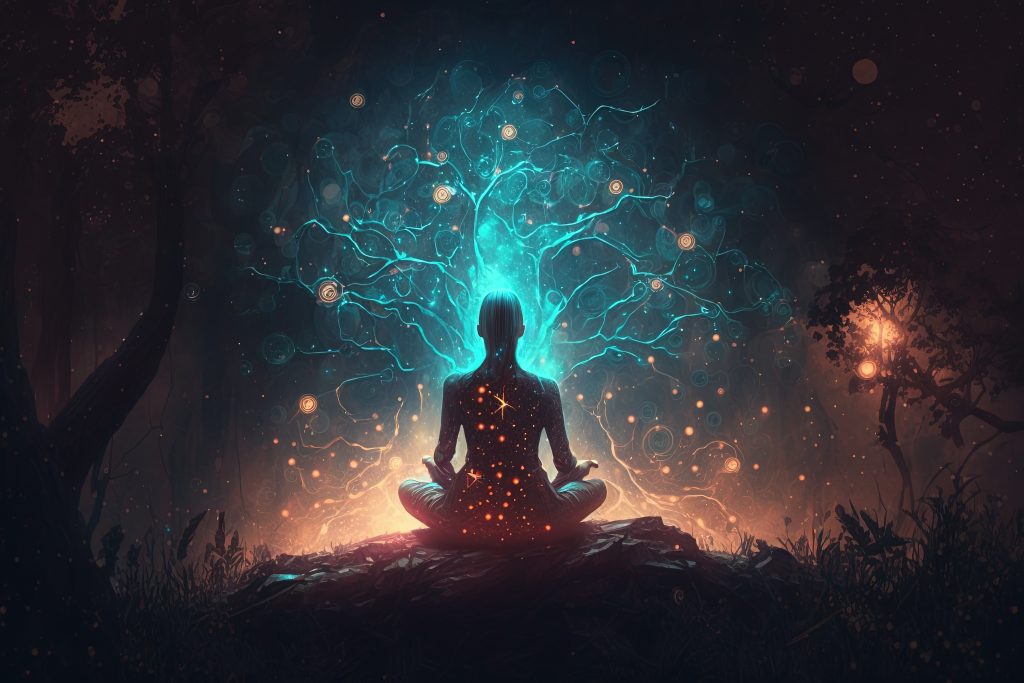The Indian Yoga Association (IYA), Uttar Pradesh Chapter, played a significant role in the Women Empowerment Seminar organized by the Institute Innovation Council (IIC) at SD College of Commerce. The event was a resounding success, bringing together experts and dignitaries to discuss critical issues surrounding…
Dr. Sangeeta Laura Biagi and
Dr. Ananda Balayogi Bhavanani
Nada is a pure vibration that is eternal: it has always existed, is always existing, and will always exist because it is the vibrational essence of the Universe. The Sanskrit term Nada expresses the quality of a “vibratory flow,” an expression of the life force, and an instrument to inquire into the nature of reality. This pure vibration is so subtle that it emanates at the level of the causal body, the Karana Sharira, also known as the astral body, the Linga Sharira. It is complex to describe this frequency of vibration because Nada is “without form” (Aroopa) and “without name” (Anaami), and it has no material qualifications (Nirguna), existing “beyond the Gunas”, the qualities of nature, and the mind. More than a quantitative substance, Nada is a qualitative essence.

Nada Yoga is often translated as the “Yoga of Sound.” However, “expressed sound” is best defined as Shabda, a term referring to that which is heard by the auditory apparatus and interpreted as noise, environmental sounds, music, or language. Nada Yoga may be defined as the theoretical and analytical understanding of the universal primordial vibration, coupled with a dedicated practice of sounds at different levels of being for the purpose of attaining universal Oneness. While Shabda can be perceived through our senses, including the sixth sense of the mind (Manas), Nada may only be perceived in the ‘Silence of the Heart’. This is the “psychic heart” of Anahata Chakra, the “wheel of energy” of “unstruck sound.” Why is silence perceived here, in the area that physically and physiologically corresponds to our heart, which pumps and beats from the day we are born to the day we die, and which corresponds also to our lungs, that receive and expel air from the day we are born until the day we die? What is the relationship between the sound of our heart pumping, our breath flowing, and the silence of their higher psychic vibration?

The silence of causal vibration is the Anahata Nada the “unstruck sound” that exists before a cause and is, therefore, causal. It is not an absence of sound; rather, it is the absorption of mind in the vibratory essence of reality. This reabsorption (Laya) is achieved in a step-by-step system of practice (Sadhana) that relies on a conscious and gradual refinement of our senses, particularly our sense of hearing, and of how we relate to sound, including the sound of our voice and the way we think and utter sound. Awareness of the perception of outer and inner sounds transforms the physiological sense of hearing into conscious listening, a precious tool to gain self-knowledge.
When left unattended, the subconscious mind creates a field of noise that clouds our capacity to experience unity with life. The untamed flow of memories from the past and projections for the future build a matrix of vibrations that keep us distracted from what is occurring here and now, in the present moment. In the first Pada of the Yoga Sutra, Maharishi Patanjali teaches us that Yoga is the quieting of such noise:

[I:2] yogaścittavṛttinirodhaḥ
Yoga is the cessation of the whirlpools of the subconscious mind
Whenever the conscious mind tries to deal with the subconscious mind, we are sucked under—this is why Swami Gitananda explains the Citta Vritti as the “whirlpools of the subconscious mind.” Before we know it, we are pulled down to the bottom of the ocean. The process of Yoga is the method of bringing these subconscious and unconscious activities up to the conscious level.
Thanks to continued practice, a blend of effort and “dispassionate detachment,” the internal noise subdues, and deeper aspects of Nada Yoga reveal themselves. Maharishi Patanjali names these two Abhyasa and Vairagya:
[I:12] abhyāsavairāgyābhyāṃ tannirōdhaḥ
Their [of the Chitta Vrittis] cessation is brought about by effort coupled with objectivity.
Step by step, Sadhakas, Seekers of Truth, learn to outgrow the “obstacles” on the Yoga path, what Maharishi Patanjali describes as the Pancha Klesha, the most challenging of which is “attachment to life and fear of death,” the survival instinct of Abhinivesha [II:3]. There is a primal connection between the noise of the Citta Vritti and Abhinivesha Klesha, and we all are called to reflect on how this manifests in our lives. Swami Gitananda used to say that most people suffer from “verbal diarrhea” and, while the image may be a bit shocking at first, we soon realize this is the truth. Most people fill their lives with noise, so they do not think about, let alone prepare for, their death. Death is part of life and Yoga Sadhana is a healthy and happy preparation for this sacred moment in our lives. When we are able to overcome the “horror vacui,” the terror of the void that we fear exists beyond noise, we can fully relax.
In Gitananda Nada Yoga, the voice, which for most people, including Yoga practitioners and teachers, is fairly unknown territory, is cultured through the understanding and practice of the Sanskrit phonemes as manifesting from the immortal sound of the Pranava AUM in the articulation of the Bija Mantras, sacred seed sounds, and their combination in longer Mantras, such as the Panchakshara Mantra Om Namah Shivaya, a salutation to Lord Shiva which contains the five syllables (Akshara) “Na,” “Ma,” “Shi,” “Va,” “Ya.” This Parampara also offers a repertoire of devotional chants, the Bhajans, and a study of classical Carnatic music which supports a Sadhana aimed at sensorial refinement, self-control, and self-knowledge. All of these “sound practices” are a means to gain mental equipoise by focusing the mind and, via “entrainment,” quiet inner and outer vibratory disturbances. The result is a blissful state of calm and serenity that may be experienced for a few seconds at first, then prolonged to a few minutes, and, with the grace of the Guru, held for an uninterrupted flow as an integral part of our everyday life.
The cultivation of inner and outer silence, Mauna, is at the heart of the teachings of Gitananda Yoga. As Yogacharini Meenakshi Devi Bhavanani, our beloved Param Pujya Ammaji, teaches us, “The Sound of Yoga is Silence.” One of the aspects of the great Lord Shiva, the “God of Yoga”, is Dakshinamurti, “the form of the divine teacher who sits in the north facing south,” the direction that is associated with the deity presiding death, Lord Yama. Sri Adi Shankaracharya, the 8th century CE philosopher and theologian of Advaita Vedanta, in the Dakshinamurti Stotra, a spiritual and religious hymn in praise of Lord Shiva, describes the Lord as Mauna Vakya, a teacher who teaches through this state of inner and outer silence which contains all sonic vibrations, just like white light contains all the vibrations of the color spectrum.

Editor’s note: We are pleased to share this excerpt from Nada Yoga: The Vibratory Essence of the Yoga of Sound by Dr. Sangeeta and Dr. Ananda published by Singing Dragon in 2023.
Dr. Sangeeta Laura Biagi and
Dr. Ananda Balayogi Bhavanani
















